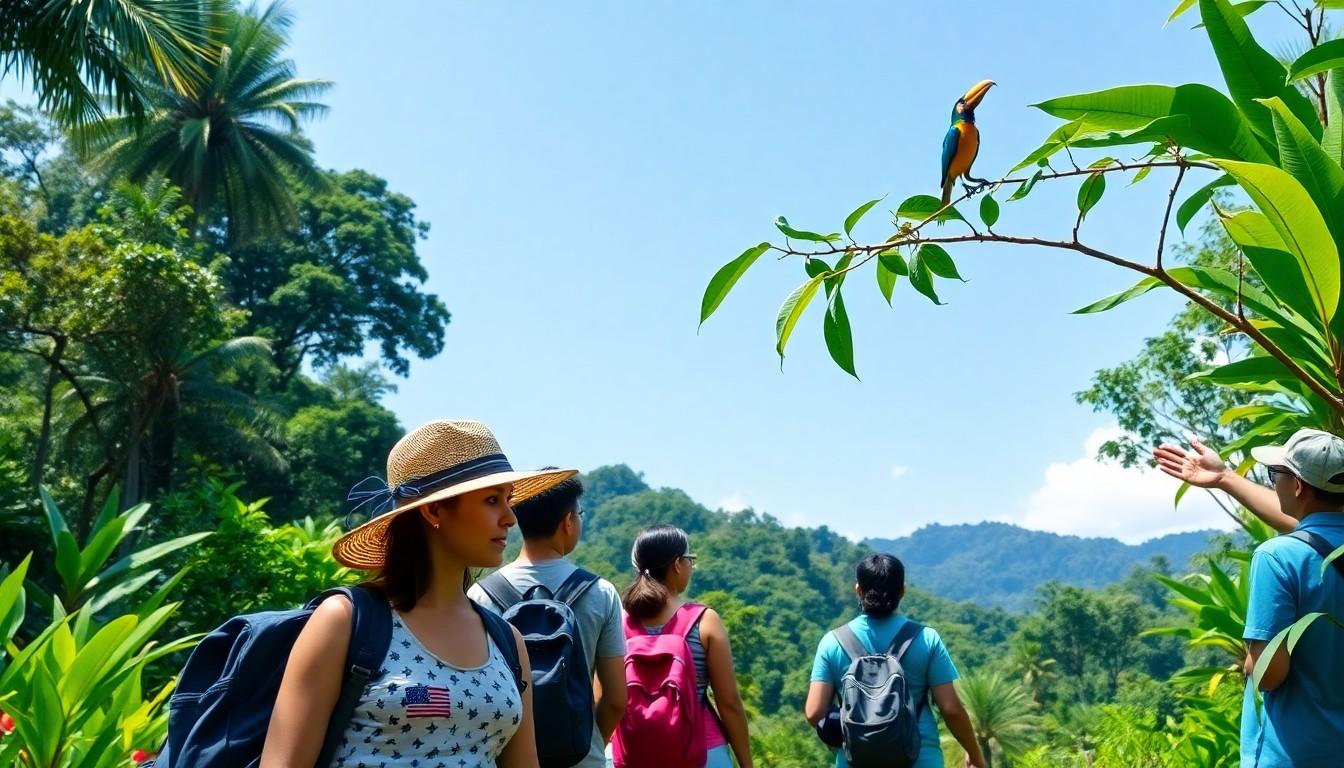
Eco Tourism Example: Discover the Best Destinations for Sustainable Travel
Imagine sipping a coconut on a pristine beach, surrounded by lush greenery and the sweet sounds of nature. Eco-tourism isn’t just a buzzword; it’s a way to travel that embraces the planet while keeping your conscience as light as your suitcase. It’s about exploring the world’s beauty without leaving a trail of destruction behind.
Eco Tourism Example
Eco tourism emphasizes mindful travel that fosters environmental consciousness while enjoying nature. This travel approach enables individuals to explore destinations responsibly.
Definition of Eco Tourism
Eco tourism encompasses responsible travel to natural areas, focusing on conservation and minimizing impact. The goal is to support local communities while promoting appreciation for their cultural and natural heritage. Travelers actively engage in activities that prioritize sustainable practices, including wildlife observation and education about local ecosystems. This form of tourism nurtures both environmental awareness and cultural sensitivity, ensuring a beneficial experience for both visitors and hosts.
Importance of Eco Tourism
Eco tourism plays a significant role in promoting sustainable practices. It encourages travelers to make choices that positively impact the environment and local communities. Financial contributions from eco tourists often support conservation efforts, preserving natural habitats. Engaging in eco-friendly travel practices fosters a deeper connection to nature, inspiring individuals to advocate for environmental causes. Additionally, eco tourism helps generate income for local communities, creating jobs and improving livelihoods.
Notable Eco Tourism Examples

Eco-tourism encompasses various exemplary destinations that showcase sustainable travel practices.
Example 1: Costa Rica
Costa Rica stands as a leader in eco-tourism, promoting conservation and biodiversity. National parks like Corcovado and Manuel Antonio draw travelers eager to explore rich ecosystems. Tour operators emphasize responsible practices, such as minimizing waste and supporting local communities through eco-friendly accommodations. The commitment to preserving wildlife is evident in initiatives like the National Biodiversity Institute. Tourists often participate in reforestation projects, fostering a strong connection with nature while impacting the environment positively.
Example 2: Galapagos Islands
The Galapagos Islands offer a unique eco-tourism experience focused on protecting its endemic species. UNESCO designated this archipelago as a World Heritage Site primarily for its diverse flora and fauna. Visitors engage in guided tours that emphasize conservation education while respecting wildlife habitats. Local operators prioritize sustainability by limiting visitor numbers and implementing strict guidelines for interactions. These efforts help the islands maintain their ecological integrity, ensuring future generations can enjoy their mesmerizing landscapes and extraordinary biodiversity.
Benefits of Eco Tourism
Eco-tourism provides numerous benefits that extend to the environment and local economies. Travelers engage in mindful experiences that support both conservation and community welfare.
Environmental Impact
Eco-tourism plays a crucial role in preserving natural ecosystems. It fosters biodiversity by promoting sustainable practices that minimize environmental degradation. Tourists often participate in activities like wildlife observation and habitat restoration. These initiatives enhance awareness about local ecosystems and encourage responsible travel behaviors. Conservation efforts funded by eco-tourism help protect endangered species and fragile habitats. Positive feedback loops emerge as local communities maintain their environments, benefiting both travelers and residents. Increased appreciation for natural beauty leads to stronger advocacy for environmental protection.
Economic Advantages
Eco-tourism creates significant economic opportunities for local communities. Job creation results from tourism activities, where locals become involved as guides and operators. Increased tourism revenue supports infrastructure improvements, education, and healthcare. Many eco-tourism ventures prioritize fair wages, ensuring that profits benefit community members directly. This financial support incentivizes conservation by making it economically viable for locals to protect their surroundings. Eco-tourism also attracts a growing market of environmentally conscious travelers, expanding business prospects. Sustainable tourism reinforces local cultures, empowering communities to preserve their heritage while driving economic growth.
Challenges in Eco Tourism
Eco-tourism faces significant challenges that impact its effectiveness and sustainability. High visitor numbers can strain natural resources, jeopardizing the delicate balance that eco-tourism seeks to maintain.
Overcrowding and Sustainability
Overcrowding in popular eco-tourism destinations leads to environmental degradation. Increased foot traffic damages ecosystems, disrupts wildlife habitats, and strains local infrastructure. Visitors may inadvertently promote waste issues through littering or overconsumption of amenities. Moreover, popular attractions can lose their appeal if they become too crowded. Solutions like visitor caps or timed entry help manage tourist flow, ensuring that natural areas remain pristine and enjoyable for future generations.
Conservation vs. Commercialization
A tension exists between conservation efforts and commercialization in eco-tourism. While some businesses prioritize environmental protection, others prioritize profits, risking the principles of eco-tourism. Unsustainable practices can undermine conservation efforts and harm local ecosystems. Tourists may unknowingly support ventures that compromise ecological integrity. Promoting businesses committed to genuine sustainability helps mitigate this issue, ensuring eco-tourism remains focused on preserving natural and cultural heritage. Collaborative efforts between governments and communities bolster responsible tourism, enhancing protections while offering economic benefits.
Future of Eco Tourism
The future of eco-tourism holds exciting potential as trends and innovations reshape the industry. New sustainable travel practices and experiences continue to emerge, increasing demand for eco-friendly accommodations and services. Notably, regenerative travel focuses not only on minimizing environmental impact but also on restoring ecosystems and enhancing local communities. Culinary tourism intertwines with eco-tourism, encouraging travelers to support local farms and learn about traditional food practices. Additionally, immersive experiences, such as wildlife rehabilitation programs, captivate eco-tourists seeking deeper connections with nature.
Trends and Innovations
Innovative approaches drive the evolution of eco-tourism. Eco-friendly transportation options like electric buses and solar-powered boats become more prominent, reducing carbon footprints. Local artisans create unique souvenirs from sustainable materials, promoting cultural heritage while minimizing waste. Community-based tourism models empower locals, ensuring economic benefits remain within communities. Research indicates that travelers increasingly prioritize sustainable choices, leading to the rise of eco-conscious travel brands. Such innovations not only bolster the eco-tourism industry but also contribute to global sustainability goals.
Role of Technology
Technology enhances eco-tourism in various ways. Digital platforms facilitate the growth of eco-conscious travel agencies, connecting eco-tourists with responsible service providers. Mobile apps provide educational resources, helping travelers learn about local wildlife and ecosystems before their trips. Virtual reality experiences promote eco-tourism by offering immersive previews of destinations, inspiring future visitors. Furthermore, social media plays a crucial role in raising awareness about conservation initiatives and eco-friendly practices. With the integration of these technologies, the industry can effectively engage and inform travelers about sustainable choices.
